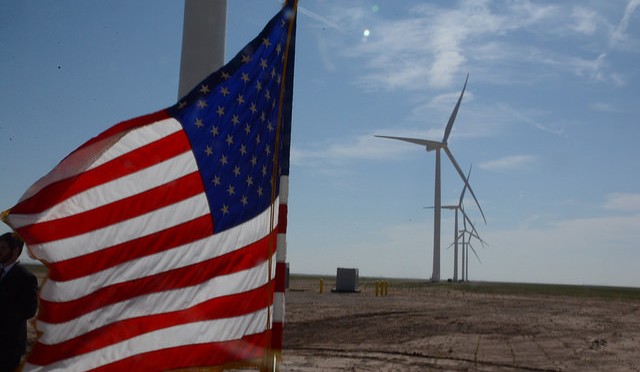Iowa, South Dakota, Kansas, Oklahoma and North Dakota all sourced more than 20 percent of their electricity generation from wind power during 2016, according to new data from the U.S. Energy Information Administration (EIA). It shows wind supplied over 5.5 percent of electricity nationwide, up from 4.7 percent in 2015.
With 99 percent of wind turbines located in rural areas, wind power’s steady growth as a share of the nation’s electricity supply has been accompanied by a surge of investment in rural America. The industry invested over $13.8 billion in new turbines last year, according to the American Wind Energy Association (AWEA), in addition to operating a fleet now over 52,000 turbines.
“Wind is now cheaply and reliably supplying more than 20 percent of the electricity in five states and is a testament to American leadership and innovation,” said Tom Kiernan, AWEA CEO. “For these states, and across America, wind is welcome because it means jobs, investment, and a better tomorrow for rural communities.”
EIA’s new data show that wind turbines operating in 40 states generated a record total of 226 million megawatt hours (MWh) during 2016, approximately four times the amount of solar electricity production and approaching what hydroelectric dams generate in America.
In Oklahoma, wind’s share of total electricity generation grew from 18.4 percent in 2015 to 25.1 percent in 2016. In Iowa, wind grew from 31.5 percent to 36.6 percent – the highest in the nation – and in Kansas, wind’s share increased from 24.1 percent to 29.6 percent. The Dakotas also saw significant gains, with South Dakota becoming the second state in the country to generate over 30 percent of its electricity from wind energy, and North Dakota rising to 21.5 percent wind.
Other states are close behind, according to EIA. In total, 14 states produced over 10 percent of their electricity from wind in 2016. Twenty states generated over five percent. New Mexico in particular posted impressive generation gains, with the state’s total annual wind generation growing by nearly 73 percent from 2015 levels, bringing the state to a 10.9 percent wind share in 2016.
Investment in wind projects results in new revenues for rural communities, which pay for roads, teacher salaries and emergency services. Wind is a new cash crop for farmers and ranchers who lease small portions of their land for wind project development, while retaining the rest for agriculture. These land lease payments added up to $245 million last year – steady income helping families make ends meet and keep farms in the family.
“Wind power is cheap, clean and infinite, and it saves Oklahomans hundreds of dollars annually on their utility bills,” said Brad Raven, District One Commissioner for Beaver County Oklahoma. “When you consider that landowners receive millions in annual royalties from wind projects, you have an energy sector that is literally saving rural Oklahoma.”
As wind power grows beyond 25 percent of Oklahoma’s electricity supply, the state’s residents will reap even greater economic benefits. The same is true across the nation.
Looking ahead, America’s grid operators have expressed confidence that they are ready for further expansion of wind power. The Southwest Power Pool, which operates the electricity grid from Montana to the northern tip of Texas, recently exceeded 50 percent wind penetration for a period of time in early February.
“Ten years ago we thought hitting even a 25 percent wind-penetration level would be extremely challenging, and any more than that would pose serious threats to reliability,” said Bruce Rew, Southwest Power Pool’s vice president of operations. “Now we have the ability to reliably manage greater than 50 percent. It’s not even our ceiling.”
A 2016 study from the National Renewable Energy Lab found that the Eastern Interconnection, which is the electricity grid comprising most of the Eastern U.S., could reliably and affordably obtain 30 percent of its electricity from wind and solar within the next 10 years using today’s technology and tools.



